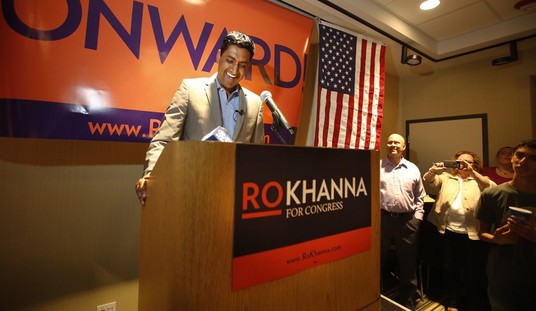I thought we had a choice in 2008 but somehow we’ve ended up with the worst aspects of an Obama presidency and a McCain presidency.
No, no, that’s unfair. Under a McCain presidency, we’d be in year three of U.S. involvement. In that alternate universe, Assad’s in a lot more trouble right now than he is in this one. But in which universe are America’s interests better served?
Moved by the Assad regime’s rapid advance, the Obama administration could decide this week to approve lethal aid for the beleaguered Syrian rebels and will weigh the merits of a less likely move to send in U.S. airpower to enforce a no-fly zone over the civil war-wracked nation, officials said Sunday…
While nothing has been concretely decided, U.S. officials said President Barack Obama was leaning closer toward signing off on sending weapons to vetted, moderate rebel units. The U.S. has spoken of possibly arming the opposition in recent months but has been hesitant because it doesn’t want to al-Qaida-linked and other extremists fighting alongside the anti-Assad militias to end up with the weapons.
Obama already has ruled out any intervention that would require U.S. military boots on the ground. Other options such as deploying American air power to ground the regime’s jets, gunships and other aerial assets are now being more seriously debated, the officials said, while cautioning that a no-fly zone or any other action involving U.S. military deployments in Syria were far less likely right now.
If we armed every truly “vetted, moderate” rebel in the Sunni ranks, we’d be talking — what? A few hundred guns? Given the urgency of the rebels’ predicament, I’m guessing the feds won’t be sticklers in defining what qualifies as “moderate”: Assad’s army, thanks to support for Hezbollah, just crushed the rebels in Qusair, cutting their supply lines. New reports claim that the Assadites are headed to Aleppo to start taking back the north of the country or, per the AP, possibly to Homs, where there are plenty of Alawite Assad fans awaiting their, ahem, “liberation.” The White House has been hoping that the upcoming peace conference with Assad would lead somehow to a ceasefire or even a settlement, but he has no incentive to talk while he;s steamrolling people. Hence Obama’s decision to start sending weapons. Until the rebels start making the regime bleed again, there won’t be any real concessions.
Meanwhile, on the ground, Shiite and Sunni forces are reaching their own inevitable “settlement”: Sectarian cleansing.
Regime forces and their allies have pushed Sunni Muslim residents out of these areas using brutal tactics, while the increasingly desperate rebels have resorted to many of the same tactics, such as indiscriminately shelling civilian areas that support the regime, they had long decried the regime for using. In some places, rebels have resorted to hiding among civilian populations in order to use them as shields against regime shelling, according to even some activists opposed to the regime…
Hafez al-Mohammed, a 25-year-old cabdriver, says he was kidnapped by Sunni rebels in late May. He says he was tortured and held captive for seven hours. His cousin Haidar says Mr. al-Mohammed was only released after Alawites threatened to retaliate by kidnapping Sunni women living in an Alawite-dominated neighborhood. “How can we ever live with them?” says Haidar referring to Sunnis.
A tour of many of these areas, from the city of Homs to many of the villages that dot the province around it, shows that the regime has cleared—cleansed is the word often used—wide swaths of the area of the Sunni Muslims, who dominate the opposition. Meantime, those Sunni residents remaining have been hemmed into neighborhoods locked down by checkpoints, harsh security procedures and even walls.
According to the WSJ, the 60,000 Sunnis and Christians in Qusair had dwindled to 10,000 before the fighting there erupted over the last few weeks. Who knows how many are left now, if any. The best-case scenario at this point appears to be a rebel resurgence, stalemate with the regime, and then partition of the country into radicalized Sunni and Shiite mini-states. (Again: That’s the best-case scenario.) Worst-case is that one of them begins to overwhelm the other and wholesale cleansing takes place. We’re not close to that happening yet — the battle for Aleppo will be longer and bloodier than the battle for Qusair, for instance — but I’m curious to know what the White House’s plan is if, six months from now, Assad’s in more of a position to make it happen. O’s new foreign-policy team of Susan Rice and Samantha Power are fans of the “responsibility to protect” doctrine. If Hezbollah and the Alawite army march north to liquidate the Sunni rebel holdouts, does the U.S. Air Force try to bomb them back south? Does the Turkish air force?
One footnote: Even if Assad continues to roll over the rebels, it’s hard to believe Hezbollah will be leaving Syria anytime soon. A revived Sunni insurrection will remain a threat for years; Iran will have to take steps to protect its man in Damascus. The obvious solution, I think, is to leave some sort of Hezbollah force stationed in Syria to help pacify the country when needed and to start training new Hezbollah brigades among Syrian Alawites. Assad and Hezbollah have always worked hand in glove as proxies of Iran, but Assad won’t be a “proxy” after this. He’ll be a true puppet whose rule was saved by Hezbollah’s intervention. If Iran wants to build out the force from Syria’s ranks, he’ll be in no position to resist.








Join the conversation as a VIP Member